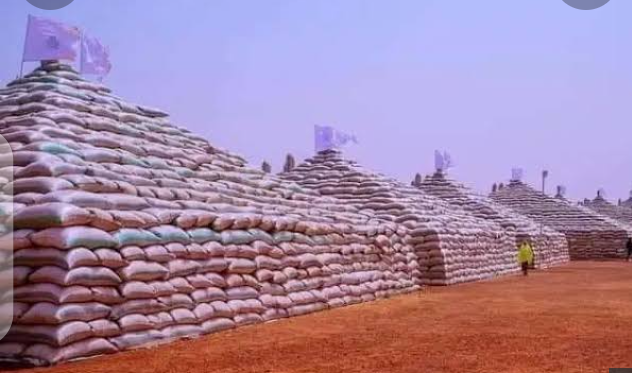By Adebanwi Sodeinde
One million bag pyramids, a celebration of inanities and deception
“Some people have problems swapping letter L with letter R, so ‘letter’ will be ‘retter’ and ‘lagos’ will be ‘regos.’ So to him Abuja bag of ‘rice’ becomes Abuja bag of ‘lies.’” This was a logic from one erudite professor in response to the news of the rice pyramid being celebrated in Abuja on Tuesday. Just while some people, under illusion, were congratulating themselves on the acclaimed one million bags of rice, claiming that there are three times more yet not on display, arising from the government support for rice farmers in 2021, many questions arise.
The Buhari government, under the supervision of the Anchor Borrowers’ Scheme implemented by the Central Bank of Nigeria (CBN), has spent N850 billion for production of rice. That amount is a huge sum already. But what is the value of the rice produced? This shall be worked out shortly. But, before then, we can also ask about the additional costs of preparing the exhibition ground as well as bringing the dignitaries from within and outside Nigeria to see the presumably outlandish ceremony. We need also to consider the cost of bringing the rice on display from various parts of Nigeria and the cost of taking them back to distribute to millers after the ceremony for posing before the camera and also the cost of engaging the media for publicity of the event.
A livestock farmer once got festoons and ribbons and an award for distinguished animals considered to have been well kept. He wondered if the animals themselves even know or appreciate the values of the award on display. In the same way, it is doubtful if the real rice farmers in the countryside actually share in or are even aware of any accolades received by the politicians and the CBN officials who came to cut the tapes in Abuja. The next couple of weeks will reveal whether or not the fortunes of these farmers farmer will improve. The period will also reveal whether or not the rice from these pyramids will be in the local markets and at what price. People will be eager to know whether the pyramids meant cheaper local rice or even costlier one.
A little rudimentary mathematical operation will suffice to provide a sense of what Abuja rice pyramid truly is, whether it makes economic sense or not. Nigeria needs seven million tonnes or 140 million bags of paddy rice to feed the people annually. That was a valid figure sometimes recently, in 2014. By then, the gap between production and consumption was about two million tonnes. That was because Nigeria was producing an estimated five million tonnes. But, because of population increase and the fact that the annual required figures are moving averages based on demographic dynamics, the figures obtained in 2014 cannot be the same as 2021. The annual gap in 2021 could not have been less than 2.5 million tonnes, meaning that Nigeria needed to have produced about 7.5 million tonnes.
Keep in mind that there has been insecurity in the countryside and many areas are inaccessible because of the activities of bandits, terrorists and killer Fulani herdsmen on the prowl. The logical thing is that in this circumstance, plus the absence of a coherent federal government policy on food production, the rice production locally should have gone way down significantly. That means a widening of the gap between production and consumption. Realistically, the gap may not have been anything less than four million tonnes. But, for convenience, let us concentrate on the 2.5 million tonnes as if nothing has gone wrong since 2014 baseline figures.
Do the farmers who produced the rice showcased at the pyramid ground have records of what they produced? What about the CBN? We are yet to account for the farmers who did not benefit from the CBN largesse called loan. This uncaptured category produces the most of our staples, including rice. But let us deal with the immediate. We are told that 3.5 tonnes per hectare is the optimal yield of rice in Nigeria, generally, based on popular varieties and breeds mostly used. But, let us reckon with improved breeds and assume that these were used by the farmers captured under CBN’s Anchor Borrowers’ Scheme. One million of 100 kg bags of rice would be 100 million kg or 100,000 tonnes. Since we are told that the rice on display was just a quarter of all that was produced, then we can conveniently multiply 100,000 tonnes by four to get 400,000 tonnes.
How many hectares of rice farm cultivation did the CBN support under the Anchor Borrowers’ Scheme? Assuming they got the yield of five tonnes per hectare, that would have required an estimted about 80,000 hectares of cultivated land cultivated in one single crop or 40,000 hectares with double cropping, using the same size of land for wet season and dry season irrigation farming of rice. Nigeria’s soft underbelly and policy weaknesses are about to be exposed by the rice pyramids. Did Nigeria produce more rice as a result of closure of Republics of Benin and Niger borders with Nigeria? How can we believe a woman who was not seen when pregnant but suddenly turns up to claim that she has just had a baby through normal delivery? With simple Maths, we may be able to unravel some things.
One million bags of rice paddy is equivalent to 100 kg X 1,000,000 or 100,000 tonnes (or metric tons, or MT for convenience). Conventionally, the chaffs constitute 35 per cent of unmilled rice,. Therefore 100 kg of rice will give 65 kg of milled rice; and 100,000 MT of paddy will give 65,000 MT of milled rice. The moving average phenomenon mentioned earlier comes into the calculation here. Population keeps growing and the baseline figure of gap between production and consumption becomes an important factor to consider. Nigeria needs about 2.5 million tonnes of paddy to meet up with the needs of the increasing population in 2021 and 2022.
Nigeria therefore needs a minimum of additional 2.5 million tonnes of rice, on top of the normal ordinary farmers’ production, to be able to come close to bridging the gap between production and consumption. The 100,000 tonnes of paddy on display on Tuesday is expected to produce 65,000 tonnes of milled rice. Since we have been told that what was on display was just a quarter of the total yield from the intervention of CBN, it means what they have altogether is (65,000 X 4) 260,000 tonnes of milled rice. Deducting the 260,000 tonnes from the (2.5 million tonnes paddy requirement or) gives 1,625,000 tonnes, a far cry. Reducing the paddy size into bags, to ease understanding, 65,000 tonnes of 50 kg rice bags should give an equivalent of 1.3 million bags of milled rice.
But total number of bags of milled rice deficit will be produced 1,625,000 tonnes, which is equivalent of 32.5 million 50 kg bags of milled rice. Notice the gap between 1.3 million milled rice from the one million bag pyramid and the 32.5 million 50 kg bags expected. It means that, altogether, when the total from CBN’s Anchor Borrowers’ Scheme (which is four times of one million) is ready, we would be having 31.2 million 50 kg bags yet to produce. Or, in simple percentage, the Anchor Borrowers’ Scheme has only produced four per cent of national production-consumption gaps in milled rice. Surely that is something to rejoice about.
Now, let us sell the 1.3 million 50 kg bags of milled rice we have thus produced at the rate of N25,000 per bag, defying the idea of government bringing down the price. For 65,000 tonnes coming from the Abuja pyramid, we will have 1,300,000 bags by N25,000. That gives N32,500,000,000 or N32.5 billion. Multiply by four to cater for all the total when the remaining three-quarters are in, then we will get N130,000,000 or N130 billion. Now, be the judge. Let a good accountant do the profit and loss analysis for a loan of N850 billion. Where does N130 billion realised stand near N850 billion? Can it be said that the CBN, in attempt to boost commercial production of rice, has therefore spent N850 billion to produce rice worth N130 billion? Or, has Buhari government simply taken Nigerians for a ride? Judge it by yourself then.
Mr Adebanwi, an Agric Economics expert lives in Abuja
Dear readers, we really need your support to keep on serving you with authoritative, truthful, and juicy stories everyday. For your support, please reach out to the editor @gavelinternational66@gmail.com

